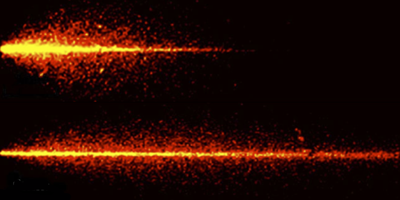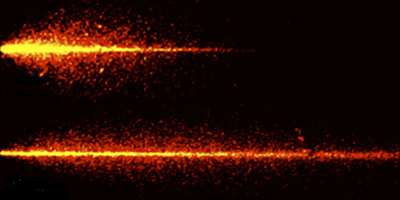Colloidally Trapped Light Needles
Milk and other colloids—nano- and micron-sized particles suspended in a fluid—are well known for their light scattering properties. In general, the refractive index of colloidal particles is higher than that of the suspending fluid; the particles have a positive optical polarization. When the solutions are illuminated with light, radiation pressure and gradient forces draw the particles to the high-intensity light-beam center, enhancing scattering further. In Physical Review Letters, Weining Man at San Francisco State University, California, and colleagues present a new tunable colloidal system that doesn’t have these problems and can be used to propagate light over centimeter distances.
The colloidal system chosen by the group was polytetrafluoroethylene (PTFE) polymer nanoparticles suspended in a glycerin-water solution. The PTFE particles were negatively polarized—they had a lower refractive index than the solution—resulting in an expulsion of the particles from the incident light beam and the formation of a particle-rich tube around the beam. This tube acted as a light guide, allowing the light beam to pass through the fluid with diminished scattering.
To tune the system, Man et al. added small amounts of positively polarized polystyrene particles. In these mixtures, the polystyrene particles were attracted to the incident light beam, while the PTFE was repelled. As the concentration of polystyrene particles was changed, the distance over which the light propagated and was focused could be tuned with stable light needles forming. The group suggests a number of uses for these light filaments and needles, ranging from controlled, localized chemical reactions to microfluidics. – Katherine Thomas





